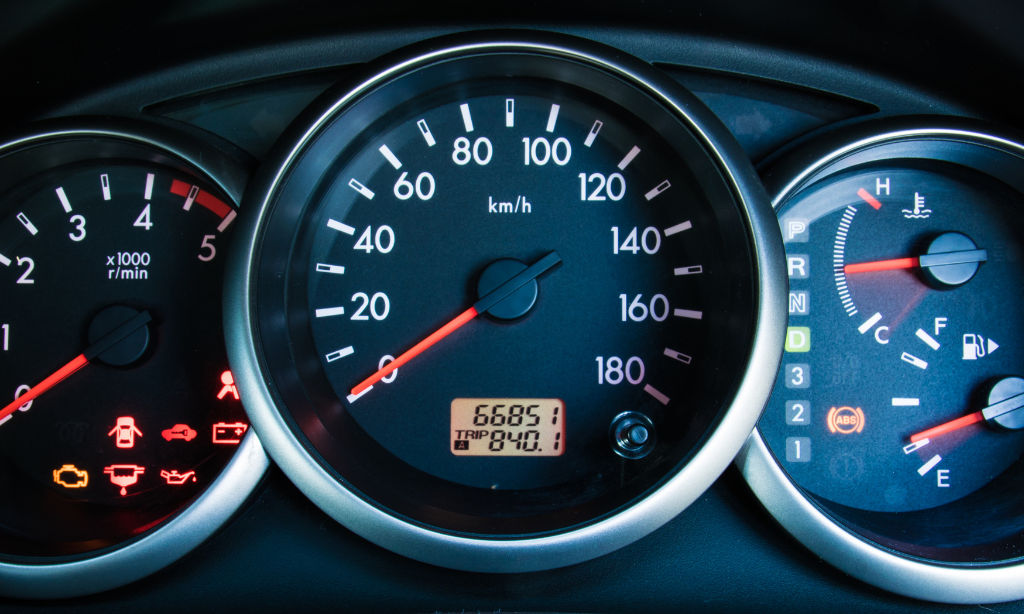Why Car Temperature Gauges Fluctuate While Driving [Ultimate Guide]
The car temperature gauge goes up and down while driving due to fluctuations in the engine’s cooling system. This can be caused by factors such as a malfunctioning thermostat or a low coolant level.
Introducing our topic, car temperature gauges going up and down while driving is a common issue that many car owners experience. This fluctuation in temperature is a result of various factors that affect the engine’s cooling system. When the temperature gauge rises and falls, it can indicate problems such as a faulty thermostat or insufficient coolant.
Understanding the reasons behind this issue is crucial to prevent potential damage to the engine and ensure a smooth driving experience. We will explore the possible causes and solutions for car temperature gauge fluctuations.
Understanding The Car Temperature Gauge
The car temperature gauge is an essential component of any vehicle, providing valuable information about the engine’s temperature. Understanding how this gauge works can help you identify and address potential issues before they become major problems. In this section, we will delve into the purpose of the car temperature gauge and its various components.
The Purpose Of The Car Temperature Gauge
- The car temperature gauge is designed to measure the temperature of the engine coolant, which helps in preventing overheating.
- It provides real-time feedback on the engine’s temperature, allowing drivers to monitor any fluctuations and take appropriate action.
- The gauge typically consists of a dial or a digital display, with a range of markings indicating the temperature levels.
- The gauge helps drivers maintain optimal engine temperature, ensuring efficient performance and reducing the risk of engine damage.
Components Of The Car Temperature Gauge
The car temperature gauge is comprised of several components that work together to accurately measure the engine’s temperature. Let’s explore these components:
- Temperature sensor: The temperature sensor is responsible for measuring the engine coolant temperature. It is usually located near the engine block or within the coolant system. The sensor detects changes in temperature and sends signals to the gauge.
- Coolant: The coolant plays a crucial role in regulating the engine’s temperature. It circulates through the engine, absorbing heat and carrying it away to be cooled in the radiator. The car temperature gauge relies on the coolant to provide accurate temperature readings.
- Thermostat: The thermostat acts as a valve within the coolant system, regulating the flow of coolant to the radiator. It opens and closes based on the engine’s temperature, allowing coolant to circulate when the engine is hot and restricting flow when it is colder. The thermostat helps maintain the optimum temperature range.
- Gauge display: The gauge display is where the temperature readings are shown to the driver. It can be in the form of a traditional analog dial or a modern digital display. The gauge may also feature markings indicating the ideal temperature range and warning indicators for overheating.
- Wiring and control unit: The wiring and control unit connect the temperature sensor to the gauge display. They transmit the signals from the sensor to the gauge, enabling the temperature to be accurately shown to the driver.
By understanding the car temperature gauge and its components, you can become more proactive in identifying any temperature-related issues with your vehicle. Regularly monitoring the gauge and being aware of any unusual fluctuations can help you take timely action to prevent engine damage and ensure a smooth driving experience.
Factors That Cause Temperature Gauge Fluctuations
While driving, you may have noticed that the temperature gauge in your car can go up and down. But what exactly causes these fluctuations? Let’s explore some of the key factors that can affect your car’s temperature gauge readings.
Engine Load And Speed:
- Driving conditions play a significant role in temperature gauge fluctuations. The engine load and speed directly impact how much heat is generated by the engine.
- When you accelerate or drive uphill, the engine works harder, causing an increase in the temperature gauge reading. Conversely, when you decelerate or drive downhill, the engine load decreases, resulting in lower temperature readings.
- High engine loads and speeds can also put extra strain on the cooling system, affecting the efficiency of heat dissipation.
Ambient Temperature:
- The outside temperature can influence the temperature gauge readings as well. Hotter ambient temperatures can cause the engine to run hotter, increasing the temperature gauge reading.
- On the other hand, colder temperatures can lead to lower temperature readings on the gauge as the engine may take longer to warm up.
- It’s essential to note that extreme temperature conditions can have a more pronounced effect on the temperature gauge, so it’s crucial to monitor it closely.
Cooling System Issues:
- Problems with the car’s cooling system can also result in temperature gauge fluctuations. A malfunctioning thermostat, radiator issue, or coolant leak can disrupt the system’s ability to regulate the engine temperature properly.
- If the cooling system fails to keep the engine cool, the temperature gauge may consistently show higher-than-normal readings. Likewise, if there’s an issue with the temperature sensor, it can lead to inaccurate readings, causing the gauge to fluctuate.
- Regular maintenance and inspections can help identify and address cooling system issues promptly, ensuring optimal engine performance and temperature regulation.
Several factors contribute to temperature gauge fluctuations while driving. Engine load and speed, ambient temperature, and cooling system problems can all impact the temperature readings on your car’s gauge. By understanding these factors, you can monitor your vehicle’s temperature more effectively and take appropriate action if necessary.
Stay attentive to your temperature gauge to prevent any potential overheating or engine damage, and consult with a qualified mechanic if you notice persistent or extreme fluctuations.
Common Temperature Gauge Fluctuations And Their Causes
Having your car’s temperature gauge go up and down while driving can be a cause for concern. It’s important to understand the common temperature gauge fluctuations and their causes in order to address any underlying issues. In this section, we will explore three different scenarios where temperature gauge fluctuations can occur: during engine start-up, during idle or stop-and-go traffic, and during highway driving.
Brief Fluctuations During Engine Start-Up
When you start your car’s engine, you may notice some brief fluctuations in the temperature gauge. Here are a few key points to understand about this phenomenon:
- The engine needs time to warm up, and during this process, the temperature gauge may initially rise but then quickly stabilize.
- This brief fluctuation is often a result of the thermostat regulating the coolant flow to maintain the optimal engine temperature.
- It is common for the temperature gauge to rise slightly during engine start-up, but it should quickly settle in the normal range.
Fluctuations During Idle Or Stop-And-Go Traffic
During idle or stop-and-go traffic, you might observe temperature gauge fluctuations. Here are some important points to note:
- The engine is working harder in these situations, generating more heat.
- The cooling system’s ability to dissipate heat becomes less efficient when the car is not in motion.
- As a result, the temperature gauge might show a slight increase, indicating that the engine is working harder to maintain the optimal temperature.
- Once you resume driving at a consistent speed, the airflow through the radiator improves, helping the cooling system regulate the engine temperature.
Fluctuations During Highway Driving
When driving on the highway, you might also notice temperature gauge fluctuations. Here are a few key points to keep in mind:
- Highway driving usually involves higher speeds, which means more airflow through the radiator.
- This increased airflow enhances the cooling system’s efficiency and helps maintain a consistent engine temperature.
- As a result, the temperature gauge may fluctuate within a narrower range compared to idle or stop-and-go traffic.
- Fluctuations in temperature during highway driving are generally minimal and within an acceptable range.
Understanding the common temperature gauge fluctuations and their causes can reassure you when you encounter them while driving your car. By being aware of the specific scenarios where these fluctuations occur, you can ensure that your vehicle’s cooling system is functioning properly.
However, if you notice any extreme or prolonged temperature fluctuations, it is always recommended to consult with a professional mechanic to identify and resolve any underlying issues. Stay informed and drive safely!
Identifying Abnormal Temperature Gauge Fluctuations
When it comes to car temperature gauges, it’s important to understand that some fluctuations are normal. However, there are instances when these fluctuations can indicate underlying issues with your vehicle’s cooling system. Being able to identify and understand these abnormal temperature gauge fluctuations can help you address the problem before it escalates into a major breakdown.
In this section, we will explore two key signs to look out for: signs of overheating and signs of a cooling system malfunction.
Signs Of Overheating:
- Rapid increase in temperature gauge: If you notice that your car’s temperature gauge is rising rapidly, it could be a sign of overheating. This can occur due to various reasons such as a malfunctioning thermostat, coolant leak, or a faulty radiator.
- Engine running hot: Another indicator of overheating is when you feel your engine running excessively hot. This can be accompanied by the smell of burning coolant or steam coming from the hood of your car. It’s crucial to take immediate action to prevent any further damage to the engine.
- Warning lights: Keep an eye out for any warning lights on your dashboard, such as the coolant temperature warning light or the check engine light. These lights are designed to alert you to potential issues with your vehicle’s temperature regulation.
Signs Of Cooling System Malfunction:
- Fluctuating temperature gauge: If your temperature gauge is constantly fluctuating between hot and cold, it may indicate a problem with your cooling system. This can be caused by issues like a stuck thermostat, faulty temperature sensor, or air pockets in the cooling system.
- Leaking coolant: Check for any signs of coolant leaks under your car or near the radiator. Coolant leaks can lead to a decrease in coolant levels, resulting in inadequate cooling and potential overheating.
- Poor performance: A malfunctioning cooling system can also affect your vehicle’s overall performance. If you notice a decrease in engine power, poor fuel efficiency, or a rough running engine, it could be due to an issue with the cooling system.
By paying attention to these signs of abnormal temperature gauge fluctuations, you can take the necessary steps to address any cooling system issues promptly. It’s essential to consult a professional mechanic if you suspect any problems with your car’s temperature regulation to avoid further damage and costly repairs.
Remember, regular maintenance and inspections can help prevent overheating and prolong the lifespan of your vehicle’s cooling system.
Effects Of Temperature Gauge Fluctuations On The Engine
Experiencing temperature gauge fluctuations while driving can be unnerving, especially when you notice it repeatedly rising and falling. Understanding the effects these fluctuations can have on your engine is crucial for maintaining the health and performance of your vehicle. Let’s explore the impact these temperature gauge fluctuations can have on your engine.
Engine Performance Impact
- Overheating: If the temperature gauge consistently rises above the normal range, it could indicate an overheating engine. This can lead to a decrease in engine performance and can potentially result in a breakdown if not addressed promptly.
- Power loss: Fluctuating temperature gauge readings can cause the engine to lose power intermittently. This can be caused by various factors, such as a malfunctioning cooling system or a faulty thermostat. It’s essential to address these issues promptly to prevent further damage.
- Poor fuel efficiency: Temperature gauge fluctuations can adversely affect fuel efficiency. When the engine is not operating within its optimal temperature range, it may consume more fuel to compensate for the inefficiency, leading to decreased mileage per gallon.
- Increased emissions: An engine experiencing temperature gauge fluctuations may emit increased levels of pollutants. This can happen when the engine’s operating temperature deviates from the recommended range, causing incomplete fuel combustion and potential damage to emission control systems.
Potential Engine Damage
- Engine wear and tear: Temperature gauge fluctuations can lead to accelerated wear and tear on engine components. The expansion and contraction caused by extreme temperature changes can damage vital engine parts, such as gaskets, seals, and internal surfaces.
- Engine seizure: If the engine temperature fluctuates dramatically, it can cause rapid expansion and contraction of various engine components. This sudden change in size can lead to seizing or warping, risking irreversible damage to the engine.
- Head gasket failure: Temperature gauge fluctuations can place excessive stress on the head gasket, which is responsible for maintaining a proper seal between the engine block and cylinder head. This stress can cause the head gasket to fail, leading to coolant leaks, loss of engine power, and potential damage to other engine components.
Temperature gauge fluctuations can have significant impacts on engine performance and potentially lead to severe engine damage if left unaddressed. It’s essential to monitor the temperature gauge closely, address any fluctuations promptly, and seek professional assistance to diagnose and resolve the underlying issues.
Regular maintenance and inspections can also go a long way in preventing temperature-related engine problems. Keep your engine operating within its recommended temperature range for optimal performance and longevity.
Preventive Measures For Temperature Gauge Fluctuations
The fluctuation of car temperature gauges while driving can be a cause for concern. It’s not uncommon for the needle on the temperature gauge to rise and fall during your journey. In this section, we will discuss some preventive measures that can help address these temperature gauge fluctuations and keep your engine running smoothly.
So, let’s dive right in!
Regular Engine Maintenance
Regular engine maintenance plays a crucial role in preventing temperature gauge fluctuations while driving. Here are some key points to keep in mind:
- Replace coolant periodically: Coolant, also known as antifreeze, helps regulate the temperature of your engine. Over time, it can become contaminated or lose its effectiveness. Regularly replacing the coolant according to the manufacturer’s guidelines is essential to ensure proper engine cooling.
- Check for leaks: Leaks in the cooling system can disrupt the flow of coolant, leading to temperature imbalances. Inspect your car for any signs of coolant leaks, such as puddles under the vehicle or a sweet smell in the air. If you notice any leaks, have them addressed promptly.
- Inspect the radiator: The radiator is responsible for dissipating heat from the coolant. Inspect it regularly to ensure it is clean and free from obstructions. Remove any debris or dirt buildup that can hinder its efficiency.
- Verify the functionality of the radiator fan: The radiator fan helps in cooling the engine when driving at low speeds or idling. Make sure it is working correctly by checking if it turns on when the engine reaches a certain temperature.
Proper Cooling System Maintenance
The cooling system of your car is vital for temperature regulation. Taking proper care of it can help minimize temperature gauge fluctuations. Consider the following points:
- Flush the cooling system: Over time, debris and contaminants can accumulate in the cooling system, hindering its performance. Flushing the system periodically can help remove these deposits and enhance the coolant’s ability to regulate temperature effectively.
- Inspect the water pump: The water pump circulates coolant throughout the engine, keeping it cool. Regularly inspect the water pump for any signs of leakage or damage. If you notice any issues, it’s best to have it inspected by a professional.
- Maintain proper coolant levels: Low coolant levels can lead to overheating and temperature gauge fluctuations. Check the coolant level regularly and ensure it is within the manufacturer’s recommended range. If necessary, add coolant to maintain the proper levels.
- Monitor the temperature gauge: Keep an eye on the temperature gauge while driving. If you notice any sudden or significant fluctuations, it could indicate an underlying issue. Address the problem promptly to prevent further damage to the engine.
Remember, preventive measures and regular maintenance are key to keeping your car’s temperature gauge steady while driving. By following these guidelines, you can minimize the risk of temperature fluctuations and ensure a smoother ride.
Troubleshooting Temperature Gauge Fluctuations
Car temperature gauges going up and down while driving can be quite concerning for any driver. Fluctuations in the temperature gauge may indicate potential issues with the cooling system of your car. In this section, we will troubleshoot the reasons behind temperature gauge fluctuations and discuss ways to address them effectively.
Checking Coolant Levels And Quality
- Insufficient coolant levels can lead to temperature gauge fluctuations. Ensure that your car’s coolant levels are within the recommended range.
- Poor coolant quality can also cause temperature gauge fluctuations. If the coolant is old or contaminated, it may not effectively regulate the engine temperature. Consider flushing and replacing the coolant if necessary.
- Check for coolant leaks as they can also affect the temperature gauge. Leakage can cause a loss of coolant, leading to overheating or inconsistent temperature readings.
Inspecting For Leaks
- Inspect the hoses and connections for any signs of leakage. Leaks can result from loose or damaged hoses, faulty gaskets, or a cracked radiator.
- Check the radiator cap for any signs of wear or damage. A faulty radiator cap can cause coolant loss and temperature gauge fluctuations.
- Inspect the water pump for leaks or damage. The water pump circulates the coolant through the engine, so any issues with it can impact the temperature readings.
By following these troubleshooting steps, you can identify the possible causes behind the temperature gauge fluctuations in your car. Remember that if you are uncertain or unable to resolve the issue yourself, it is always advisable to consult a professional mechanic for further assistance.
Getting Professional Help For Temperature Gauge Fluctuations
If you notice that your car’s temperature gauge is constantly fluctuating while driving, it may be a cause for concern. While slight variations in temperature are normal, significant or frequent fluctuations could indicate underlying issues that require professional attention. Ignoring these signs can lead to severe engine damage and costly repairs down the line.
In this section, we will discuss the signs that indicate the need to consult a mechanic and the importance of diagnosing and fixing cooling system issues promptly.
Signs To Consult A Mechanic
If you experience any of the following signs, it’s crucial to seek professional help to prevent further damage to your vehicle’s cooling system:
- Repeated overheating: If your car’s temperature gauge consistently reaches the red zone or nears it, it’s a clear indicator of a problem. Overheating can lead to engine damage and should be addressed immediately.
- Erratic temperature fluctuations: If you notice that the temperature gauge rapidly moves from hot to cold and back again, it could signify a malfunction in the cooling system. This issue requires assessment by a qualified mechanic.
- Coolant leaks: If you observe puddles of coolant under your vehicle or notice a sweet, pungent odor, it indicates a coolant leak. This leakage can result in insufficient coolant levels, leading to temperature irregularities.
- Visible steam or smoke: Any visible steam or smoke coming from the engine compartment indicates a severe cooling system problem. Continuing to drive in such conditions can cause irreversible damage and should be avoided.
Diagnosing And Fixing Cooling System Issues
When faced with temperature gauge fluctuations, it’s crucial to have a professional mechanic diagnose and fix the underlying cooling system issues. The cooling system is complex and comprises various components that work together to regulate the engine’s temperature. Here’s what the mechanic will do:
- Perform a cooling system inspection: The mechanic will conduct a thorough inspection of the entire cooling system, including the radiator, coolant hoses, water pump, and thermostat. This evaluation will help identify any faulty or worn-out components.
- Check the coolant level and quality: The mechanic will examine the coolant level to ensure it is sufficient. They will also assess the coolant’s quality, looking for signs of contamination or degradation that may hinder its effectiveness.
- Inspect the radiator fan: The mechanic will examine the radiator fan to ensure it is functioning correctly. A malfunctioning fan can lead to inadequate cooling, resulting in temperature gauge fluctuations.
- Test the thermostat: The mechanic will test the thermostat to verify its proper functioning. A faulty thermostat can cause temperature irregularities, leading to overheating or insufficient heating.
- Address identified issues: Based on their findings, the mechanic will address any issues within the cooling system. This may involve repairs or replacements of faulty components, flushing the coolant system, or fixing leaks.
Regular maintenance and prompt attention to cooling system issues are vital to keeping your vehicle’s engine functioning optimally. By consulting a professional mechanic, you can address temperature gauge fluctuations promptly and prevent further damage to your car’s cooling system.
Remember, if you experience any of the signs mentioned, it’s crucial to seek professional help as soon as possible. Ignoring these symptoms can lead to severe engine damage, leaving you with a hefty repair bill. Keep your car’s cooling system in top shape and enjoy worry-free driving.
Conclusion
To sum up, understanding why car temperature gauges go up and down while driving is crucial for maintaining the health and performance of your vehicle. Fluctuating temperatures can be a sign of various underlying issues, such as thermostat problems, cooling system malfunctions, or even engine damage.
Regular maintenance and timely inspections can help identify and address these problems before they escalate. It is important to pay attention to any unusual changes in the temperature gauge and take appropriate action, whether it be adding coolant, checking for leaks, or seeking professional assistance.
By staying proactive and addressing these issues promptly, you can ensure the longevity and safety of your vehicle on the road. Remember, a properly functioning temperature gauge is an indispensable tool for every responsible car owner.
- Why Are My Car Headlights Not Bright Enough? - May 9, 2024
- How Long Can You Drive With An EVAP Leak? - May 9, 2024
- What Does B Stand for in a Car? [Full Guide] - May 9, 2024



![Metric Vs Standard Wrenches [What’s The Difference?]](https://automhelp.com/wp-content/uploads/2023/06/Quick-reference-standard-wrench-sizes-in-order-SAE_000049455-768x432.webp)

![How To Easily Reset Oil Light On The Jeep Renegade [A Quick Guide]](https://automhelp.com/wp-content/uploads/2023/07/Easily-Reset-Oil-Light-On-The-Jeep-768x461.png)
